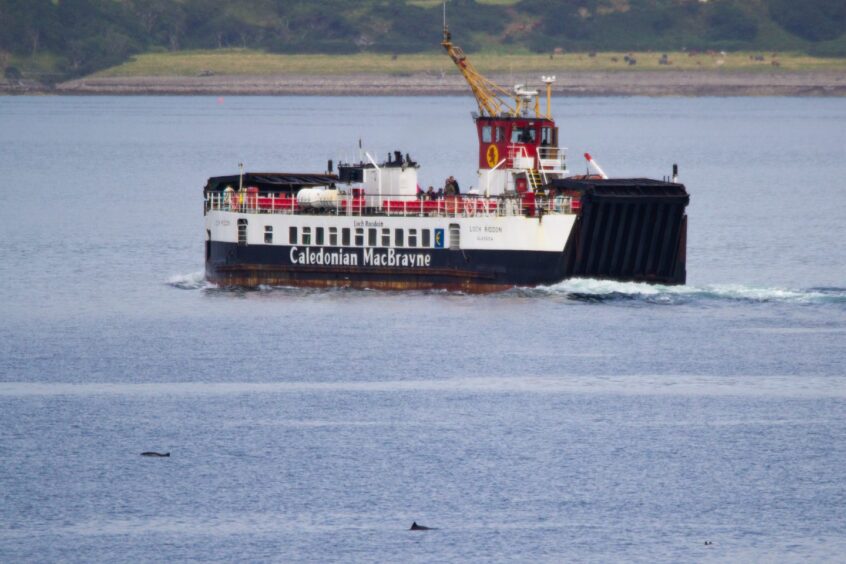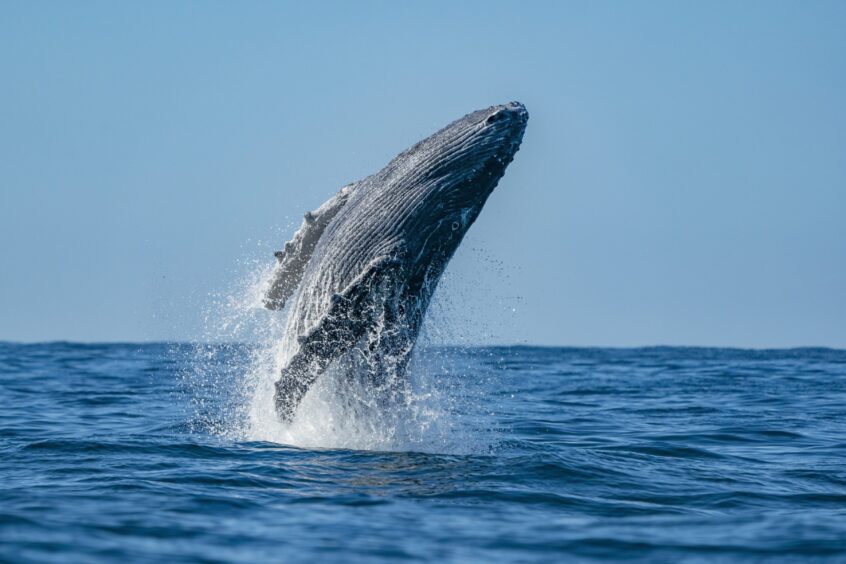
Two humpback whales and a pod of 280 dolphins were just a tiny fraction of the sea life spotted on Scottish ferry routes last year.
More than 2,000 dolphins, whales and porpoises made a splash alongside CalMac ferries in 2023.
New data has revealed those routes most popular with cetaceans.
If you’re going whale watching in Scotland, these are the ferry routes that offer the best chance for a sea life spectacle.
Marine conservation charity ORCA analysed more than 20,000 kilometres of ocean in 2023.
Nearly 6,900km of which fell on routes sailed by CalMac vessels.
Bill Anderson is just one of the many volunteers who carries out the work each year and said he was “hooked” after his first training in 2018.
“I love doing it,” he said. “I love being out on sea, anyway.
He added: “I would be quite happy to just stand there and watch nothing but to see the animals as well, it is just a bonus.”
While ORCA undertakes surveys on a range of cruises, Bill described the CalMac routes as the “bread and butter” of the surveyors located in the West of Scotland.
But one island in Western Isles came up as the top destination for those who want to go dolphin and whale watching in Scotland.
Where were the dolphin and whale sightings?
But that tallied up to total of 2206 individual animals, including a major pod of 280 dolphins…
And rare humpback whale sightings.
Yet, most marine activity was recorded in August.
And 189 animals were recorded between Ullapool and Stornoway in 59 sightings.
While 86 cetaceans were recorded in just four sightings on the Mallaig – Lochboisdale route.
Close behind 65 were seen in 19 sightings between Uig, Lochmaddy and Tarbert.
Finally, 7 cetaceans were recorded in the three sightings on the Oban to Craignure route.
Bill also highlighted the Barra route as his top route to survey and revealed one reason why it may be abundant with sightings.
“It is a good route because you get three and half hours of uninterrupted surveys.
He added: “It’s an overnight stay so you get meet the other surveyors a bit more.”
Western Isles waters ‘just so full of life’
ORCA’s volunteers have been recording whale and dolphin sightings on CalMac ferries since 2017.
The partnership is part of the ferry operator’s Marine Awareness Programme.
ORCA’s volunteer citizen scientists, known as Marine Mammal Surveyors, devote their spare time to surveying the seas from the ferries.
The data is gathered through distance sampling. A group of four takes turns with two surveyors observing either the starboard or port side.
A third records the data and the fourth rests, before the roles are switched every half hour.
We are really proud to have our marine awareness programme and we are really proud that it opens up access for groups like this to be able to access the natural environment.” Emily Meyers of CalMac
“We are not spending any longer than half an hour staring in the water,” Bill said. “Otherwise the data would become skewed, you do get tired doing it.”
Emily Meyers, environmental compliance specialist at CalMac, said the operator was “happy to facilitate this kind of important work”.
“When I saw that report of all the places they had been and they highlighted two of our routes, and how many cetaceans they saw on those trips, it was amazing. It is just so full of life.”
She added of the marine life monitoring: “It is not just about supporting organisations, for us it is an opportunity to be more involved in important conservation work and understand the environment we are operating in.
“We are really proud to have our marine awareness programme and we are really proud that it opens up access for groups like this to be able to access the natural environment.”
As the vessels use regular routes over long periods of time, ORCA can maintain accurate data specific to the areas where they operate.
Which ship is the MV(P) of whale watching in Scotland?
But there can be some overlap of ships on different routes.
By ship, MV Isle of Lewis had the highest number of cetaceans recorded with 751 animals in 149 sightings.
But it is closely followed by MV Clansman, also sailing from Oban, with 102 sightings of 531 individual animals.
The chart below shows that sightings were consistently recorded each month from April to September for the MV Isle of Lewis.
However, third place is taken by the ship with the fewest sightings – 387 cetaceans were seen on board MV Coruisk in just 10 sightings.
MV Isle of Lewis had its highest monthly number of marine animals in July.
The sightings will also depend on the timing of surveys. But across Scotland, ORCA carried out 97 surveys over 14 ferry routes.
It is the “highest level of effort record in a single year”, after 20,011 kilometres were surveyed.
Emily added that she shared ORCA’s report with the masters of the vessels.
“Hopefully they got a good surprise out of it,” she said.
“It is especially nice for them to see the work that is being carried out alongside them.”
Humpback whales weren’t the only lucky sightings
Diving deeper into the types of animals, ferry passengers had some special viewing opportunities.
Alongside humpback whale sightings, on both the Oban-Castlebay and Ullapool-Stornoway routes, there were also minke whale and fin whale sightings.
But dolphins were the most popular sighting throughout the survey period – with 1,714 recorded individuals.
ORCA also reported a “marked” increase in Risso’s dolphin sightings on surveyed routes in their 2023 report.
Known for a diet of squid and other cephalopods, the stocky cetacean was recorded 20 times on CalMac routes.
But the appearances were only on the Ullapool-Stornoway and Uig-Lochmaddy-Tarbert routes.
Meanwhile, Minke whales were recorded on almost all of the CalMac routes studied with Mallaig-Lochboisdale being the only exception.
Yet the only species seen across all routes was the common dolphin.
The State of Cetaceans report states that porpoise numbers have fluctuated since 2017.
In 2023, there was a slight increase on the Ullapool–Stornoway route since 2022.
The deputy director of ORCA, Lucy Babey, said the data “helps safeguard these animals and their homes for future generations”.
“CalMac has given us the opportunity to monitor, and learn more about, the diverse and exciting wildlife around the Hebrides,” she said.
“If you’re travelling with CalMac over the summer months, keep your eyes peeled as there’s so much incredible wildlife to be sighted.”
When is the best time to go dolphin and whale watching in Scotland?
ORCA recorded the most individual cetaceans on CalMac routes in August last year.
A total of 766 dolphins, whales or porpoises were recorded in 136 sightings.
Meanwhile, in May, volunteers recorded 628 animals in over 51 sightings.
The data only starts at the end of March, so the month has the fewest sightings.
However, the timings of the surveys will have an impact on the number of sightings.
The volunteers aim to be as consistent as possible so the data can be comparable to previous years.
Even the team layout will generally contain the same range of experience levels each time.
“The data needs to be carried out the same each time,” Bill explained.
“By having the same balance of skills on the team, it means that surveys done five years ago are done nearly in the same way as it is about to be.”
Each of the CalMac routes are surveyed once a month during the summer.
Most of the actual sightings took place at 8am, followed by 3pm.
But the CalMac’s summer sailing timetable put a limit on the possible sighting times.
So, no sightings took place before 7am nor after 8pm.
However, if you want to go whale watching in Scotland and are not a fan of early starts, 11am was the second-most popular morning contender with 39 sightings.
The more, the merrier when it comes to whale watching sightings?
More than a third of the sightings were of a single animal (39.1%).
But there were some significant outliers with some lucky sightings of pods over 80 individuals.
Only 5.66% of the sightings included 20 or more individuals.
In fact, sightings of five or fewer individuals account for 78.1% of those recorded in 2023.
Bill explained that while pods of 280 might be more unusual, big pods are not uncommon.
“You do see them,” he said. “Not all that often, but you quite regularly see pods of at least 50 or 60.
“It gets hard trying to count them when it gets like that.
“What I tend to do is draw an imaginary line across the water and then any animals that come in front of that line I count as a new animal.
“It can become very difficult, especially if they are swimming from different directions. You always underestimate.”
The surveyors use binoculars that measure the distance from the horizon and with “a bit of trigonometry”, they can also work out the distances of the pod from the ship.
He added: “I think dolphins bring smiles to everyone’s faces. When you see a pod like that, you do remember it.”
But what were dolphins and whales up to?
Most of the cetaceans were simply seen swimming.
Yet some also showed different behaviours, like milling, where the animals have little or no directional movement but instead socialise with each other.
The marine animals were also feeding, breaching and fast swimming in some sightings.
While the breaching behaviour was recorded less commonly, one of Bill’s most memorable moments surveying on the CalMac ships was seeing a breaching animal.
However, it wasn’t a whale or dolphin, but a basking shark.
“That was quite a special thing to see,” he said.
“They are not cetaceans, we generally survey cetaceans, whales, dolphins and porpoises.
“To see a basking shark leap out of the water was quite special.”
But even just a quick cetacean glimpse can add to a whale watching trip in Scotland.
Speaking about a recent similar experience with a different biodiversity group, Emily said passengers can really benefit from having the experts surveying on board.
“It adds something really rich to their experience of where they are going.”

Conversation